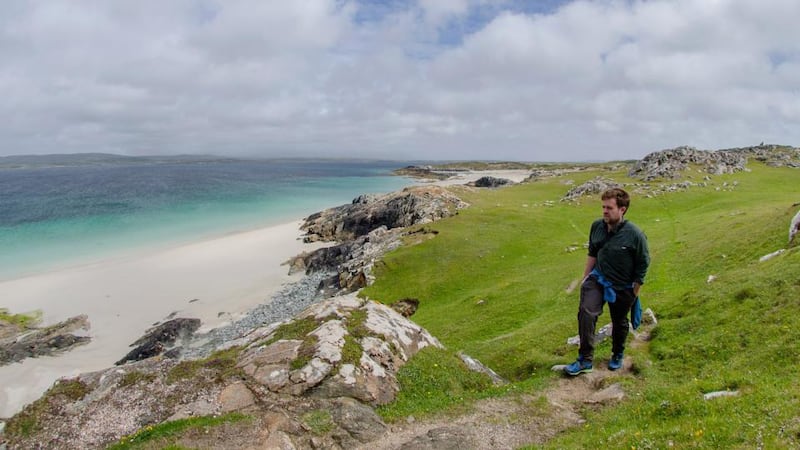|
Mannin Bay, Connemara, Co Galway
Map: OSI, Discovery Series Sheet 44.
Time & distance: About 7km/2 hours.
Suitability: Easy enough but there are some slippery rocks to navigate and cliffs to avoid.
Start/finish: From Clifden head for Roundstone. After about 8.5km, beyond the Coral Strand but before you reach the shop and pub at Ballyconneely, turn right towards Mannin Lodge B&B and the Connemara Sands Hotel. Follow this narrow road over a bridge and keep right when another road veers left. Your start point is up ahead on the right at a gate leading into open grassland, where the road swings left to a private house.
|
The Irish landscape is often a lesson in very subtle colours, the hills shifting gradually through browns and beiges, the sky and sea often grey. But on a sunny day the coast of Mannin Bay in Connemara is super-saturated, with lime-green grass, blonde sands and water like clear blue gin.
We set off to walk the grassy commonage here on a gusty bright day. To the north-east the silhouette of the Twelve Bens was a liquid grey, hidden behind rainclouds. From the parking spot, go through the gate (make sure to close it after you, and be aware there is livestock on the commonage) and follow the fence. When you reach the beach, turn left and head west. You can now follow the coast for a few kilometres. This is essentially a linear walk, but we explored the shore on the way out, and the grassland above it on the way back.

We found beadlet anemones, coloured a deep crimson, in the rockpools, and the shells of big spider crabs in the sand. Mannin Bay is named for Manannán mac Lir, according Connemara’s great chronicler, Tim Robinson. Manannán was an Irish sea god depicted in the eighth-century The Voyage of Bran travelling the seas in a chariot. He was also considered an ancestor of the Conmhaícne Mara, the people for whom Connemara is named.
The Mannin Bay Blueway, a series of kayaking and snorkelling trails, is nearby at Coral Strand on the main road from Clifden. The Coral Strand is composed not of sand, but the fragmented remains of calcified algae. I spent a glorious half-hour snorkelling in the bay with friends last summer, watching cuckoo-wrasse dart through the purple-brown seaweed, and shore crabs scuttle over rocks.
Back on this walk, you will encounter sandy beaches divided by small headlands. After a while the long sandy arc of Trá Fhada stretches in front of you, towards Knock hill. But rocky promontories prevented us from walking the length of the beach on the sand, so we had to head inland to get around them.
The walking on the shore can also be trickier in places than the soft plains above, with slippery rock and some small scrambles. Take care of small cliffs too (and look out for sand martin nest holes in sandy cliff faces).
At the west end of Trá Fhada is a small stream, and just beyond this is a hefty fence with “private property” signs, so sadly you can’t explore the coastline further. We turned back towards the car and moved inland, roughly following sandy roads that criss-cross the commonage.
This grassland is machair, a habitat that only occurs in the west of Ireland and Scotland, when sandy coastal pasture is lightly grazed. This produces a smooth-carpet with diverse wildflowers. Lady’s bedstraw, bird’s foot trefoil and eyebright were all flowering when we visited. You will come to a ditch not far from the start point: you can get across it down at the beach, as we did near the start of our walk, or there are stepping stones near the junction with another ditch at the inland edge of the commonage. We arrived back to the car just as the grey rain arrived, draining glorious Mannin of all its colour

















